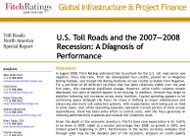Article from: www.thenewspaper.com/news/28/2805.asp
6/12/2009
Fitch Ratings Forecasts the Need for Massive Toll Increases
Credit ratings agency report suggest hard-hit motorists will be paying more to use toll roads.
 A major credit rating agency yesterday released a report reinforcing a negative outlook on the financial stability of the toll road industry. Fitch Ratings analyzed the performance of forty US toll road facilities during 2007 and 2008. It predicted that the roads would not see a recovery from the recession until 2011 at the earliest and that motorists would be paying more money in tolls as a result.
A major credit rating agency yesterday released a report reinforcing a negative outlook on the financial stability of the toll road industry. Fitch Ratings analyzed the performance of forty US toll road facilities during 2007 and 2008. It predicted that the roads would not see a recovery from the recession until 2011 at the earliest and that motorists would be paying more money in tolls as a result.
"Fitch expects the cost of highway travel to increase in real terms -- something that generally hasn't happened in the US historically," the report stated. "In other words the days of declining real toll rates may be gone. And while beneficial in the near term, higher toll rates over time could present challenges in the next downturn as the value of a low toll rate has borne itself out in this recession."
The report emphasized how industry performance is at an all-time low. Traffic on thirty-three toll facilities dropped 4 percent in December 2008 compared to 2006 -- the largest such plunge since data was first collected in 1970. Revenue did not fall as sharply as traffic because most of the toll roads introduced sharp rate hikes to cover losses. During the same period, stand-alone toll road revenue dropped only 1.5 percent. For some roads, that may not be enough.
"Most toll facilities have debt-service obligations that grow to varying degrees over the next several years, so anything more than a temporary decline in revenue would be problematic," the report explained. "Several facilities within the dataset have actually raised rates and shown little to no revenue growth -- indicating that they are already maximizing revenue and, at least for the near term, have no real ability to stem the losses. These assets also have a growing debt burden and, not coincidentally, they have the lowest ratings."
Turnpikes, on the other hand, used their "near monopoly position" to boost rates on drivers so much that revenue increased 4.3 percent even though traffic plunged 6.4 percent. The New Jersey Turnpike, for example, raised driving costs by fifty percent. Still, no matter how high the rates are now, tolls will likely increase yet further after the economy recovers.
"Many of the toll increases put in place over the last year are funding essential system rehabilitation and/or expansion," Fitch stated. "As a result, while revenue trends have outperformed traffic, more debt is being taken on -- pushing the day of reckoning out a few years. It is Fitch's view that traffic will remain stagnant over the next few years as the economy struggles to regain its footing and toll increases beyond those planned for will likely be needed on many facilities to maintain financial flexibility in the face of growing debt service."
Fitch used the threat of rating downgrades to compel toll roads to make the desired toll hikes. A bad credit rating increases the cost of financing and could seriously harm the financial viability of a highly leveraged toll deal.
"To the extent individual facilities do not cut back on capital or are politically unable to raise tolls, rating action could be taken," the report stated.
Overall, Fitch has downgraded or changed the outlook to negative on ten out of forty projects since its August report. Only two facilities improved.
 A major credit rating agency yesterday released a report reinforcing a negative outlook on the financial stability of the toll road industry. Fitch Ratings analyzed the performance of forty US toll road facilities during 2007 and 2008. It predicted that the roads would not see a recovery from the recession until 2011 at the earliest and that motorists would be paying more money in tolls as a result.
A major credit rating agency yesterday released a report reinforcing a negative outlook on the financial stability of the toll road industry. Fitch Ratings analyzed the performance of forty US toll road facilities during 2007 and 2008. It predicted that the roads would not see a recovery from the recession until 2011 at the earliest and that motorists would be paying more money in tolls as a result.